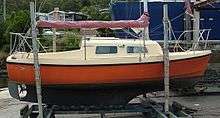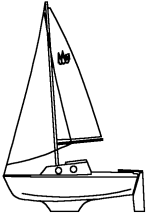Pocket cruiser
A pocket cruiser is a sailboat designed for recreational cruising and club racing, under 30 feet (9 m) in length.[1]

Like the similar and usually smaller trailer sailer they have design features to make it possible to tow them with passenger vehicles, such as light weight, and short ballasted retractable shoal draft keels.
Being cruisers, they also include amenities that provide the comfort of larger boats, such as a cabin, with berths, a galley, a head, and cockpit.
Properly equipped, these style boats are capable of long offshore passages,[2] as proven by circumnavigators Eric and Susan Hiscock, Lin and Larry Pardey, and Tania Aebi, among others.
The term was coined in the 1970s as fiberglass sailing yacht building took off.[3]
Performance

Pocket cruisers are, in general, not fast boats; the short waterline and wide beam required to provide the basic accommodations generally limit their speed. Because of this, designers are willing to sacrifice additional performance for ease of use. Traditional rigs, like gaff rigs, are not uncommon, compared to the nearly universal high aspect Bermuda rigs found on other modern sailboats. The lower aspect rigs lose some windward abilities, but make up for it in superior downwind performance and ease of use. The West Wight Potter 15, for example, uses a unique sail design that is a cross between a gaff sail and a Bermuda sail, which gives it more sail area on a shorter mast than would be possible with a true Bermuda sail; this gives a greater sail area with less heeling force than a taller, narrower sail.
Closeness to the water, smaller relative size compared to the wave height, and a lighter ballast to displacement ratio can combine to create a perception of high performance. Some selected small cruisers are designed with flat profiled aft bottom sections and are capable of actually coming up on a plane in breezy to marginal wind conditions.
Examples

One of the smaller commercial pocket cruisers was the Guppy 13, made by Melen Marine Ltd. in California. They made about 300 of them in the period between 1974 and 1975. The Guppy was a fiberglass boat with a shoal draft keel, and would sleep 2 adults in a 6 ft 8 in (2.0 m) cabin. Overall length was 12 ft 6 in (3.8 m), beam was 5 ft 7 in (1.7 m); displacement was 480 lb (218 kg) with 150 lb (68 kg) of ballast in the keel. It drew 1 ft 7 in (480 mm) empty, and flew a Bermuda rig consisting of a 32 square feet (3 m²) high aspect main sail and a 48 square feet (4.5 m²) jib (technically a genoa since it overlapped the main). Length at waterline was 11 ft 10 in (3.6 m), giving a hull speed of just under 4.5 knots (8 km/h). The shallow V hull was not designed to plane, but is generally considered very capable at cutting through choppy water.
In Australia, the best known and most popular pocket cruiser is the locally produced Savage Nautilus, a shoal draft yacht of 19 feet 4 inches (5.89 m) length overall with a 7 feet 10 inches (2.39 m) beam and a full length keel that draws only 2 feet 9 inches (0.84 m). Fitted with an 8 horsepower (6.0 kW) Yanmar diesel inboard motor (an unusual feature in a boat so small) and capable of sleeping four adults, they were produced in large numbers and have proved incredibly popular with Australian pocket cruising enthusiasts. Loosely based on a lifeboat design, they are sufficiently stable and heavily constructed to sail offshore and some have made long distance blue water crossings, such as the notorious waters of Bass Strait, between mainland Australia and the island state of Tasmania (including the pictured example, "Bullwinkle", which was sailed from Brisbane to Hobart).
See also
- Deutschland-class cruiser, also known as a Pocket battleship, an unrelated military vessel.
- Day sailer
- Newport 16
- PocketShip
- Sandpiper 565
- Com-pac 16
- Lysander (boat)
- MacGregor Yacht Corporation
- SCAMP (boat)
Notes
- "Best Pocket Cruiser Sailboats, Small Cruising Boats". Cruising World. Retrieved 12 June 2019.
- "Popular Cruiser Yachts under 30 feet (9.1m) Long Overall". Sailboat Cruising. Retrieved 12 June 2019.
- Sailing, Blue Water (12 March 2019). "Pocket Cruisers That Sail Far". Blue Water Sailing. Retrieved 12 June 2019.